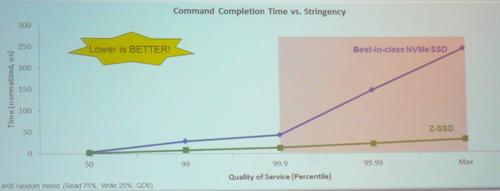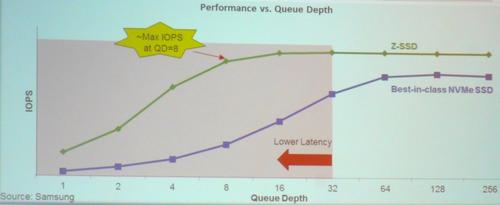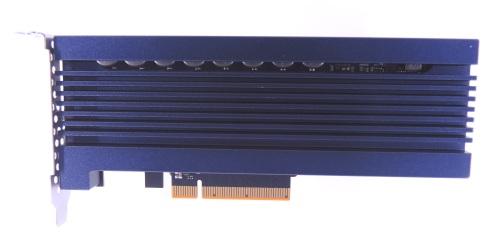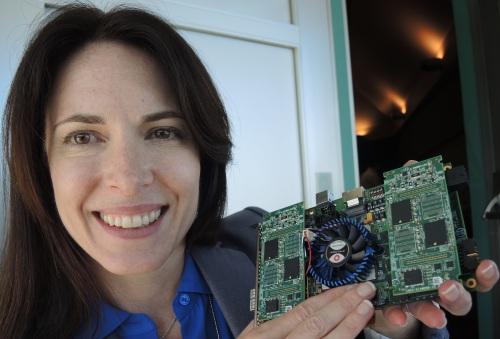
Samsung lobbed a new variant of its 3D NAND flash into the gap Intel and Micron hope to fill with their emerging 3D XPoint memory. The news came one day after Micron showed at the Flash Memory Summit performance figures for its version of the XPoint solid-state drives (SSDs) under a new Quantx brand.
Samsung announced plans for what it called Z-NAND chips that will power SSDs with similar performance but lower costs and risk than the 3D XPoint drives. However, it was secretive about the details of the technology that will appear in products sometime next year.
By contrast, a Micron engineer leading its XPoint SSD program was surprisingly candid in an interview with EE Times. She described current prototypes using early XPoint chips and an FPGA-based controller for the SSDs expected to ship in about a year.
Samsung’s Z-NAND will deliver 10x faster reads than multi-level cell flash and writes that are twice as fast, the company said. At the drive level, they will support both reads and writes at about 20 microseconds, suggesting some of write performance comes from an enhanced controller.
The Z-SSD throughput in I/O operations/second (IOPS) will be “comparable to the new Micron Quantx products,” peaking at a desirably low level of about eight queue levels, said Tien Shiah, a Samsung product marketer who said results were based on working hardware in the lab.
The first drives will have a terabyte capacity. Like today’s high-end SSDs they will draw a full 25W from a PCIe Gen 3 slot to deliver maximum IOPS.
Costs will be “a little bit more than standard triple-level cell flash shipping today, but it will be more cost effective than alternative memory technologies,” said Shiah, in a nod to 3D Xpoint.
Engineers from Toshiba and SanDisk interviewed independently by EE Times said they believe Z-NAND is a clever implementation in a 3D NAND process of single-level flash cells. Shiah said Z-NAND will have “SLC-like endurance.”
Samsung does not appear to have a version of Z-NAND available for NVDIMM boards that plug into a memory bus. However Intel suggests it will not attack that opportunity with XPoint until sometime well after the first SSDs emerge next year.


Z-SSDs claim latency (top) and performance levels that rival 3D XPoint drives. (Images: Samsung)
Samsung’s move appears to be a somewhat hastily-prepared but savvy one. It positions an existing, relatively low cost technology against a newer riskier one still trying to yield.
One analyst expects Intel and Micron may take a loss on initial XPoint products until volumes rise. Intel may try to recoup the loss by selling XPoint as part of a platform with more expensive processors. “It’s a gamble,” said Jim Handy of market watcher Objective Analysis (Los Gatos, Calif.).
Samsung positioned Z-NAND as a sort of special case, a defensive move outside its main flash road map. Its next major product will be a 512-Gbit chip with 64-layers delivering 800 Mbits/second, said Jae Jeong, head of Samsung’s memory division.
Samsung showed at its booth a wafer bearing the chips it said will ship later this year. It will use the chips to put a terabyte of storage into a novel fan-out package developed internally, he said. The chips will be used to double to 32 TBytes the density of Samsung’s high-end SAS-based SSDs.
Next page: Micron gives peek at XPoint SSD

Samsung showed a prototype Z-SSD at its booth.
Micron’s SSD team got the first working samples of 3D XPoint chips in February. If all goes well, they will have sample drives in users’ hands by this time next year.
“We were uncertain three months ago whether we would have a demo running” at the Flash Memory Summit, said Stefanie Woodbury, a Micron director overseeing the SSD effort. Getting stable working media is “the gating factor” for the drive, she said.
The team hopes to get proper engineering samples by the end of the year and fully qualified samples early next year. Currently, the prototype drive uses a pin-compatible socket in a media daughter card so it can drop in new chips as they emerge from the fab about every 60-90 days.
In a sign of the new ground the team is plowing, it has been inventing new terms such as slivers, slices and rakes to describe XPoint drive phenomenon. To minimize risks, the SSD will use nearly 90% of existing controller and firmware designs.

Micron's Woodbury showed a prototype Quantx drive complete with heat sink for its controller currently implemented in an FPGA. (Image: EE Times)
Like the media, the NVMe interface is still evolving. “We hear new [NVMe] proposals every day even though the version 1.2.1 is trying to close,” she said.
Separately engineers need to tape out a controller currently implemented in an FPGA. The chip is being developed by a third-party controller vendor under an exclusive agreement.
Micron supplied media architects and less than 20 veteran firmware engineers for the SSD design. They are co-located with the controller designers in a Colorado office.
“We wanted to keep the firmware and controller architects close…it always helps to have more face-to-face time at white boards,” said Woodbury. The biggest non-technical challenge of the effort has been to “get the three groups of controller, firmware and media architects to be a seamless team to get away from finger pointing,” she said.
The final products will come in three form factors -- U.2 and M.2 modules using four PCIe Gen 3 lanes and a half-sized add-in card using eight lanes.
Woodbury brings a “customer’s pint of view” to the design, having previously worked on the Compellent storage systems at Dell. She also spent ten years at Seagate developing high-end disk drives including its first product using perpendicular recording.
----Form EE Times